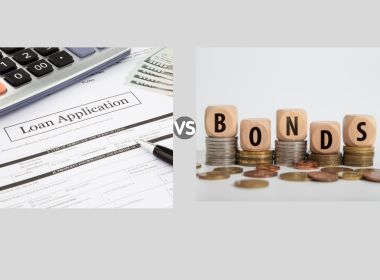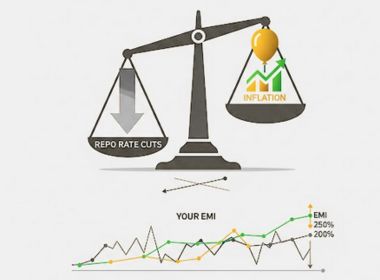Search Suggestions
- Gold Loan
- Money Transfer
- Mutual Funds

Interest Rate vs APR: Which One Matters More for Your Personal Loan?
Availability of a personal loan can be stressful and time-consuming. However, availing a loan is not simply about paying interest rates. As a borrower, you must know the costs that come along with repayment. There are two things that a borrower must know, i.e. the interest rate and APR, whose full form is annual percentage rate.
Table of content
- What is an Interest Rate?
- What is APR?
- Interest Rate vs APR
- How to Calculate the Interest Rates and APR on a Loan?
- Why is APR Higher than Interest Rates?
- Things to Remember while Availing Personal Loans
Both APR and personal loan interest rates are two sides of the same coin and are expressed as a percentage. Their meaning may differ on a subtle level. However, knowing the differences between these two can help borrowers make better decisions
Whether you are seeking a personal loan or using your credit card, both come with interest rates which you must pay during repayment. Both APR and interest rate are the two most important measures of the price that you must pay for borrowing money. This blog highlights the differences between APR & interest rate and which one is more significant.
What is an Interest Rate?
Interest rates are generally advertised as the cost you have to pay the lender for borrowing money. This gives you a gist of what you have to pay on top of the loan amount or principal. If the interest rates are higher, you’ll repay more over the life of your loan.
Suggested Read: Major factors that affect Personal Loan interest Rates
What is APR?
Annual percentage rate, on the other hand, is the interest rate and additional fees charged by the lender. These fees can be broker fees, processing fees, closing costs and other charges. APR gives you a clearer idea with an accurate figure of the total cost of a loan.
Interest Rate vs APR
APR | Interest Rate |
Gives you a broader look at what you have to pay when you borrow money. | Gives you a narrow look at what you have to pay when you borrow money. |
It calculates the cost of processing fees and closing costs. | It does not include other fees connected with your loan. |
This is mainly controlled by the lender, and the percentage is determined by using the borrower’s credit score. | This is calculated by the lender and can also be determined by using the client’s data, such as credit score. |
Represents the percentage of the amount borrowed. | Represents the percentage of the amount borrowed. |
Lower APR often translates to a lower total loan cost. | Lower interest rates often translate to lower monthly payments, even if the total loan is more expensive. |
How to Calculate the Interest Rates and APR on a Loan?
Interest rates are calculated as a percentage of your loan amount, and the formula is I = Principal amount X rate X time, I = (P x r x t). Let’s say you borrowed 5,00,000 INR at an interest rate of 8% over two years. The total interest amount for the loan over the tenure would sum up to 80,000 INR. The percentage of interest rate is predetermined by the lender.
Whereas, APR is calculated by knowing the interest rate on your loan. Here, the total interest amount is 80,000. Let’s say there are no additional fees involved for the loan amount you borrowed. By applying this formula, APR = ((Interest + Fees) / Principal) / Number of Days in Loan Term x 365 x 100%. Your APR would be 8%, however, if there were additional fees, then the APR would be higher than the interest rate.
Why is APR Higher than Interest Rates?
APR is mainly composed of the interest rate stated on a loan, which includes processing fees, discount points, and other fees paid to the lender. APR is usually higher than the stated interest rate because of the upfront costs that are added to the principal balance of the loan.
Things to Remember while Availing Personal Loans
- Based on your needs, focus onAPR vs interest rate – If you want the best deal on your monthly payments, then simply focusing on APR would be the best thing to do. However, if you’re more concerned about saving money in the long term, it would be wise to give more attention to interest rates.
- Be aware of the loan term –While some borrowers look for loans with longer repayment terms, so they can keep their monthly payments low. However, it’s important to remember that you will end up paying more in interest, with a longer term. It is of utmost importance that you weigh the overall cost of a longer loan term.
- Ask about additional fees, if any – APR can be a powerful tool to compare loan offers, if there are no additional costs, then your APR won’t be higher than the interest rate.
You can easily apply for a personal loan by visiting the nearest Muthoot Finance Branch, where you can get a better understanding of the benefits offered by Muthoot, such as the best personal loan interest rates, quick disbursal and minimum documentation.
- Instant Personal Loan
- EMI Calculator
- Document Required
- Track Personal Loan
- Interest Rate
- Procedure and Eligibility
CATEGORIES
OUR SERVICES
-

Credit Score
-

Gold Loan
-

Personal Loan
-

Cibil Score
-

Vehicle Loan
-

Small Business Loan
-

Money Transfer
-

Insurance
-

Mutual Funds
-

SME Loan
-

Corporate Loan
-

NCD
-

PAN Card
-

NPS
-

Custom Offers
-

Digital & Cashless
-

Milligram Rewards
-

Bank Mapping
-

Housing Finance
-

#Big Business Loan
-

#Gold Loan Mela
-

#Kholiye Khushiyon Ki Tijori
-

#Gold Loan At Home
-

#Sunherisoch
RECENT POSTS

How to Choose the Right Tenure for Your Car Loan?
Know More
Consumer Loan vs. Personal Loan: Key Differences You Should Know
Know More
How to Check an Active Loan on a PAN Card?
Know More
Differences Between Loans and Bonds
Know More
MCLR vs EBLR - Which One Saves More on Home Loans?
Know More
BNPL vs Personal Loan: Which is Better for Instant Finance?
Know More
How to Protect Yourself from Loan Fraud in India?
Know More
SIP vs SIF Fund: Meaning, Differences and Best Mutual Fund Option
Know More
Mudra Loan vs MSME Loan: Key Differences Every Small Business Owner Must Know
Know More
Daily SIP vs Monthly SIP: Which is Better?
Know MoreFIN SHORTS

Difference Between Personal Loan and Consumer Durable Loan
Know More
Checklist Before Applying for Gold Loan Online
Know More
5 Steps To Get Your Business Ready For An Sme Loan
Know More
5 Solid Reasons To Choose Sip Over Fixed Deposits
Know More
5 Best Mutual Fund For Retirement 2025
Know More
Are Commercial Vehicle Loans Beneficial?
Know More
Why Digital Gold Loans Are Gaining Traction in 2025
Know More
Gold Price Forecast for the Next 6 Months
Know More
Why Travel Is Now the Top Reason for Indians to Take Personal Loans
Know More
Repo Rate Cuts, Inflation, and Your EMI: Navigating Personal Loans in 2025
Know More
A ₹10,000 SIP Could Turn into Crores?
Know More
NPS Repairs: 6 Big Reforms Everyone Should Know
Know More- South +91 99469 01212
- North 1800 313 1212


